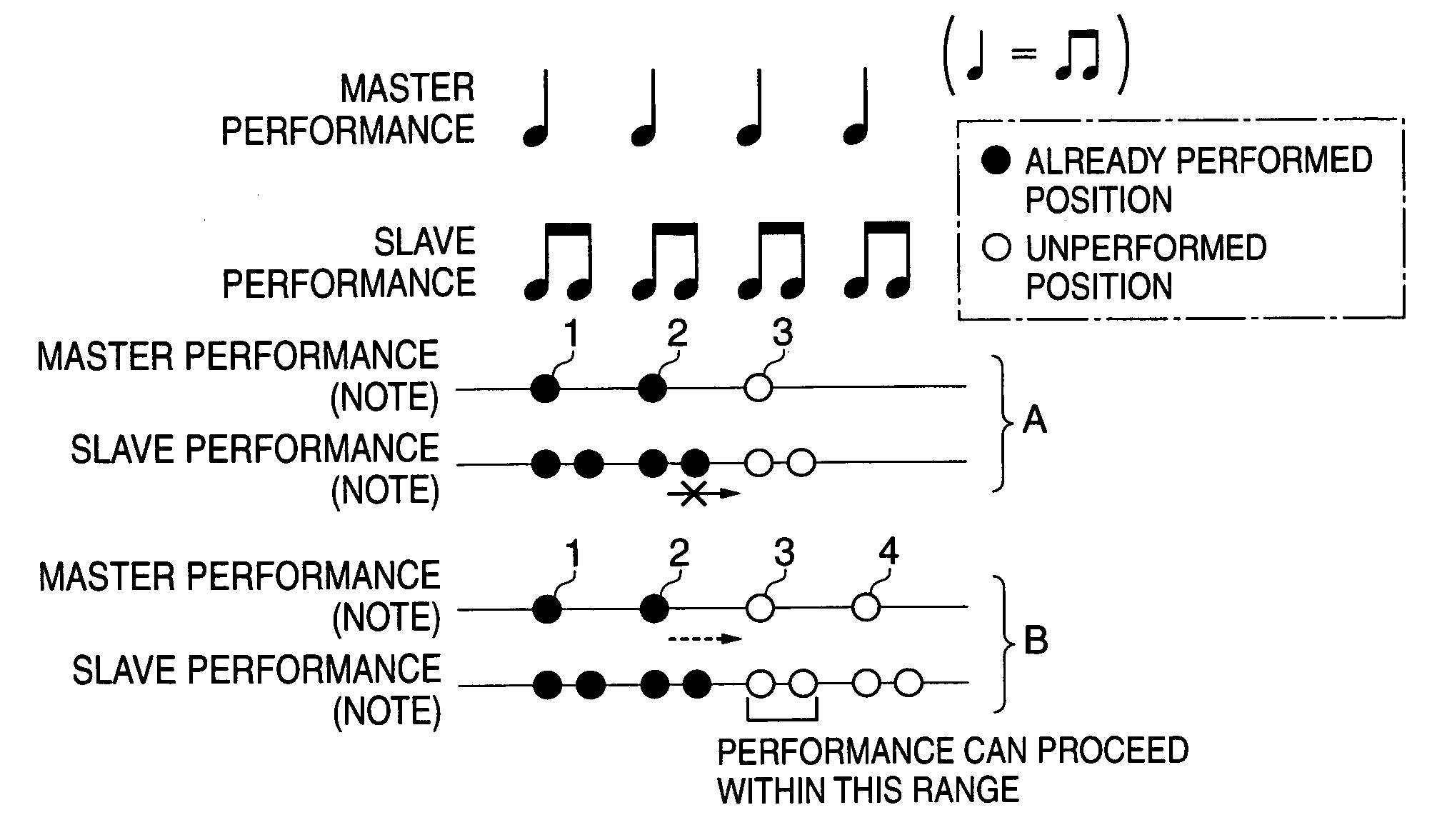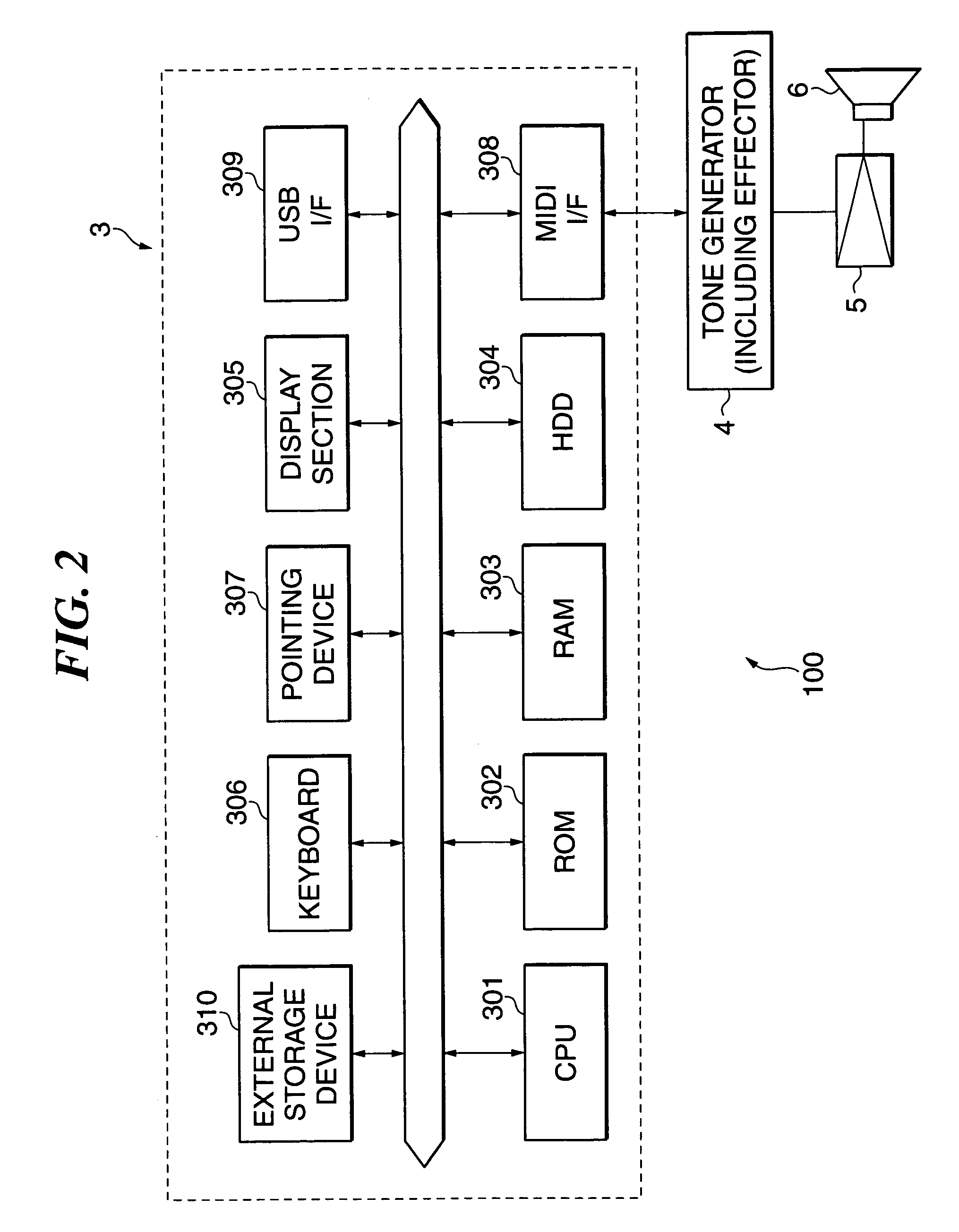Automatic performance apparatus and automatic performance program
a technology of automatic performance and performance apparatus, applied in the direction of electrophonic instruments, instruments, etc., can solve the problems of inability to carry out expressive ensemble performance with a sense of uniformity, large difference in the progress of performance between a plurality of parts,
- Summary
- Abstract
- Description
- Claims
- Application Information
AI Technical Summary
Benefits of technology
Problems solved by technology
Method used
Image
Examples
case 1
(Case 1)
[0116]FIG. 13 is a view useful in explaining a performance process in a case 1 in the multiple operating element performance mode.
[0117]The CPU 301 constantly checks the next performance position of the master operating element (operating element as the master) 1-1 (the position at which a sounding event is to be processed next) to provide control such that the current performance position (the position at which a current sounding event is being processed) of the slave operating element (operating element as the slave) 1-2 does not go beyond the next performance position of the master operating element 1-1. Namely, the CPU 301 provides control such that the slave performance does not proceed ahead of the master performance. For example, as shown by an example A in FIG. 13, at a time point the CPU 301 receives operation information from the master operating element 1-2, if the operation of the slave operating element 1-2 is detected in the case where the master performance ha...
case 2
(Case 2)
[0118]FIG. 14 is a view useful in explaining a performance process in a case 2 in the multiple operating element performance mode.
[0119]When the operation of the slave operating element 1-2 is detected only in timing corresponding to a part of a piece of music where the performance of the melody part is interrupted and only the accompaniment part is performed, such as during an interlude in a piece of music, as shown by an example A in FIG. 14, the CPU 301 causes the slave performance to proceed in the timing in which the operation of the slave operating element 1-2 is detected. However, the slave performance can be caused to proceed only within the part of the piece of music where only the accompaniment part is performed. In other words, as shown by an example B in FIG. 14, the slave performance can be caused to proceed to a position immediately before an unperformed position “1” where the master performance is resumed. It should be noted that whether the performance positi...
case 3
(Case 3)
[0120]FIG. 15 is a view useful in explaining a performance process in a case 3 in the multiple operating element performance mode.
[0121]In the case where the operation of the slave operating element 1-2 is detected at the same time when the operation of the master operating element 1-1 is detected, or is detected within a predetermined period of time (such as 300 ms) after the operation of the master operating element 1-1 is detected, the CPU 301 causes the slave performance in the timing in which the operation of the slave operating element 1-2 has been detected. For example, as shown by an example A in FIG. 15, if the operation of the slave operating element 1-2 is detected at the same time when the operation of the master operating element 1-1 is detected when the slave performance has proceeded to a position immediately before an unperformed position “3” of the master performance, the CPU 301 causes the master performance to proceed to a performance position “3” and caus...
PUM
 Login to View More
Login to View More Abstract
Description
Claims
Application Information
 Login to View More
Login to View More - R&D
- Intellectual Property
- Life Sciences
- Materials
- Tech Scout
- Unparalleled Data Quality
- Higher Quality Content
- 60% Fewer Hallucinations
Browse by: Latest US Patents, China's latest patents, Technical Efficacy Thesaurus, Application Domain, Technology Topic, Popular Technical Reports.
© 2025 PatSnap. All rights reserved.Legal|Privacy policy|Modern Slavery Act Transparency Statement|Sitemap|About US| Contact US: help@patsnap.com



